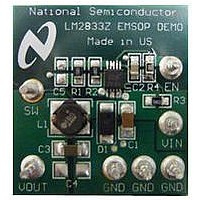LM2833ZMYEVAL National Semiconductor, LM2833ZMYEVAL Datasheet

LM2833ZMYEVAL
Specifications of LM2833ZMYEVAL
Related parts for LM2833ZMYEVAL
LM2833ZMYEVAL Summary of contents
Page 1
... R2, a 47nF ceramic ca- pacitor is usually a good choice for C5. Note for applications where VOUT is close to VFB, since R1 is small, the effective- ness of adding C5 becomes decreasingly appreciable. There- © 2009 National Semiconductor Corporation National Semiconductor Application Note 1845 Alex Gao ...
Page 2
Typical Performance Characteristics Efficiency vs Load Current Load Regulation Startup (V Slew Rate = 1V/ www.national.com Efficiency vs Load Current 30062302 Startup (V 30062304 Steady-state (CCM Mode) 30062306 2 30062303 Slew Rate = 0.2V/µ 30062305 30062307 ...
Page 3
Steady-state (DCM Mode) 30062308 Load Transient (Slew Rate = 0.1A/µs) (C5 not installed) 30062314 Line Transient 30062316 Steady-state (Pulse Skipping) Load Transient (Slew Rate = 0.1A/µs) (C5 = 47nF) Loop Gain 3 30062309 30062315 30062317 www.national.com ...
Page 4
... TABLE 1. Bill of Materials Part Value 3 C3216X5R0J226MT GRM216R71A224KC01D JMK316BJ476ML-T Open Open CRCW08052K00FKEA CRCW08052K00FKEA CRCW080510R0FKEA CRCW0805100KFKEA 4 Bottom Layer Internal Plane 2 (VIN) Part Number Manufacturer LM2833ZSD National Semiconductor NP04SZB1R0N Taiyo Yuden TDK Murata Taiyo Yuden CMS01 Toshiba Vishay Vishay Vishay Vishay 30062311 30062313 ...
Page 5
Notes 5 www.national.com ...
Page 6
... For more National Semiconductor product information and proven design tools, visit the following Web sites at: Products Amplifiers www.national.com/amplifiers Audio www.national.com/audio Clock and Timing www.national.com/timing Data Converters www.national.com/adc Interface www.national.com/interface LVDS www.national.com/lvds Power Management www.national.com/power Switching Regulators www.national.com/switchers LDOs www.national.com/ldo LED Lighting www ...





